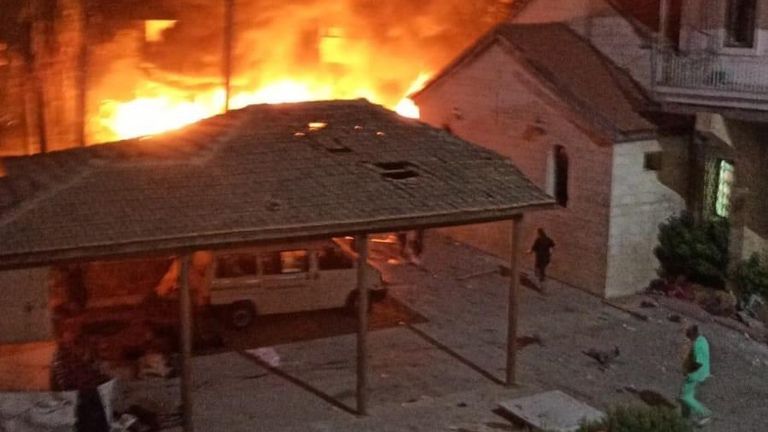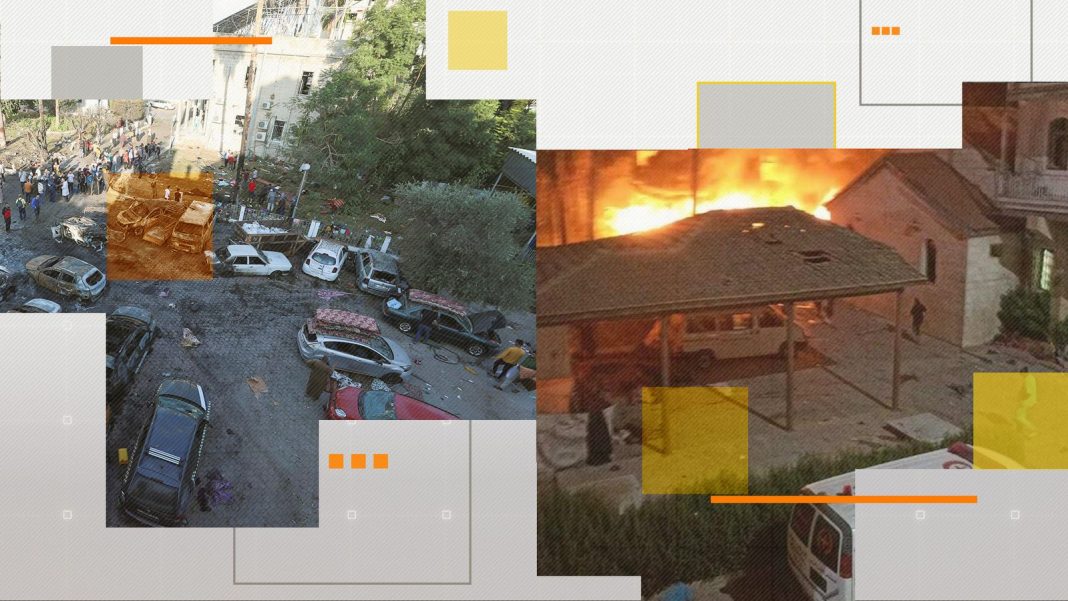The deadly explosion at Gaza’s Ahli Arab hospital remains shrouded in uncertainty, as Israeli and Hamas officials continue to blame each other for the blast.
Gaza’s health ministry says 500 people lost their lives in the incident on Tuesday evening – which would make it the deadliest incident in the territory since 2008.
Hamas says it was caused by an Israeli airstrike, but the Israel Defence Forces and US intelligence say it was a rocket misfired by Hamas ally Palestinian Islamic Jihad that struck the hospital. The militant group has denied this.
Protests spread around Middle East – live updates on Israel-Hamas war
Much about what happened at the hospital remains unclear, with competing narratives, pictures and videos circulated by either side claiming to support the opposing positions of both Israel and Hamas.
However, analysts have told Sky News that initial damage assessments “do not reflect what we would expect to see from an Israeli airstrike”.
Sky News has analysed videos, pictures and social media evidence to clarify what we know about the incident.
The Al Ahli al Arabi hospital in Gaza City
Projectiles in the sky
The Al Alhi al Arabi hospital is situated in Gaza City, the densely populated capital of Gaza where Palestinians have been warned by the Israel Defence Forces to evacuate to the south.
Some of the earliest visual evidence we found of the blast comes from a live broadcast stream operated by the news outlet Al Jazeera in the city centre.
At 6.59pm local time, the feed shows what appears to be a single projectile flying through the sky.
It’s after nightfall, which makes it difficult to identify exactly where the object has been fired from.
The camera tracks the path of the missile for around 13 seconds before it explodes in the sky, although it’s not immediately obvious from the footage why this might be.
The object then stops being visible on the stream, and seconds later a large flash can be seen below the camera’s line of vision.

The Al Jazeera camera faces eastwards in its final frame, capturing the blast at the hospital
When the camera pans down, it shows a separate large explosion at the hospital grounds – which is just under a mile away from the camera’s position, according to Sky News’ geolocation.
But the Al Jazeera feed is not the only visual evidence we found depicting the blast. Two cameras positioned across the border in Israel also captured the incident – one from the north and the other east of the Gaza Strip.
Please use Chrome browser for a more accessible video player

0:08
A live broadcast from Channel 12 and footage from a CCTV camera near the Erez border north of Gaza appear to show visual evidence of the blast
The clip on the left is taken from a live broadcast from the Israeli television outlet Channel 12, while the right-hand footage is taken from a CCTV camera in a village not far from Gaza’s main border crossing at Erez.
The timestamp on the Channel 12 footage says 6.59pm – matching the time captured on the Al Jazeera broadcast.

Sky News has found footage from three cameras – placed north, west and east of the hospital – showing the same incident
Projectiles are seen being fired in the sky to the west of the hospital in the moments before the explosion there.
Despite the lack of a time stamp on the right-hand footage, both clips show a similar pattern, angle of fire and stopping position just before the ground explosion at the hospital site.
Explosion’s damage exposed
Pictures and videos of the blast’s aftermath also provide an insight into how the incident unfolded.
One video shared online immediately after the blast shows the impact from a nearby residential block.
Justin Bronk, a military analyst at the Royal United Services Institute (RUSI), noted the explosion in the video doesn’t match up with what one would expect to see from an airstrike.
Writing on X, formerly Twitter, he noted that the flames appear to be generated by propellant fire rather than from the detonation of an explosive.
However, he clarified that the quality of the video and the fact it was taken at night makes it difficult to be definitive.
An image depicting a blaze inside the hospital grounds was one of the first pieces of visual evidence Sky News saw circulating online following the incident, posted around 7.27pm.

An explosion is seen at the hospital in Gaza City. Pic: X
Sky News analysis of corroborating images confirms that the picture is in the northern section of the hospital complex.

The first image was geolocated to the hospital. Pic: Google Maps
We analysed two other videos from two different angles showing the same area we see in the first image. In the videos, you can see vehicles on fire while one video shown below depicts the same area on fire.

A screengrab from one of the videos at the scene of the blast
A woman shouts: “They’ve hit us with airstrikes… we cannot see a single thing… oh my God, how am I meant to get out? What is going on?!” as she leaves the building.
Below, you can see the area of the hospital where the images and videos were located highlighted by the yellow box.

Video was geolocated to this area within the Al Ahli al Arabi hospital grounds. Pic: Google Maps
The aftermath
Pictures captured the following day show a clearer picture of the scene of the explosion.
They show a number of burnt vehicles and one which was overturned in the car park of the hospital. The roof of one of the buildings next to the car park also appears to be damaged – although buildings do not appear to be completely destroyed.

Source: Reuters/Ahmed Zakot
Another picture shows what appears to be a crater left by the impact.
We analysed the size of the crater and found it to be approximately one metre wide and 33cm deep – which is relatively small.

Experts say the crater is much smaller than what one would usually expect from an Israeli airstrike. Source: Reuters/Mohammed Al-Masri
Rebecca Shrimpton, defence director at the Australian Strategic Policy Institute, says that this, coupled with other aspects of the blast damage, make it unlikely to have been caused by an Israeli strike.
“There is significant evidence of fire, structural damage to cars – but this doesn’t really fit with the same kinds of patterns that you would see after an Israeli airstrike.”
“You would expect to see significant cratering, far more structural damage, cloud and powdering after these strikes,” she told Sky News.
“It looks like a lot of the damage was fire, and that this fire was the result of a significant amount of fuel and not from the explosion of the warhead.”
However, she pointed out that it’s too early to be definitive about who is to blame for the attack.
This sentiment is echoed by Joe Truzman, research analyst at the Foundation for Defending Democracies.
“It’s difficult to discern what happened based on the evidence so far,” he told Sky News.
“But what we do know is that there is a history of rockets fired by Palestinian armed groups falling short and landing on top of buildings and civilian infrastructure.”
Despite the lack of evidence making it impossible to be sure at this stage about who was behind the attack, both analysts emphasised how the incident demonstrates that the conflict between Israel and Hamas is fought with information as much as it is with weaponry.
“It takes hours, even for sophisticated military intelligence capabilities, to look at all the available evidence and come to conclusive evidence about exactly what happened,” said Ms Shrimpton.
“The speed with which some of the headlines were promulgated was remarkable.
“It’s a reminder that the nature of this war is kinetic, but highly informational as well.”
The Data and Forensics team is a multi-skilled unit dedicated to providing transparent journalism from Sky News. We gather, analyse and visualise data to tell data-driven stories. We combine traditional reporting skills with advanced analysis of satellite images, social media and other open source information. Through multimedia storytelling we aim to better explain the world while also showing how our journalism is done.







